 Well, here’s Roc, age five weeks.
Well, here’s Roc, age five weeks.
This could be the last time He’ll be able to see where he’s going until his first shearing/plucking.
It’s just amazing how fast their hair grows.
Why, I remember when he was just a little guy, eyes still closed and barely a gloss of hair to hint what colors he or his sisters would be.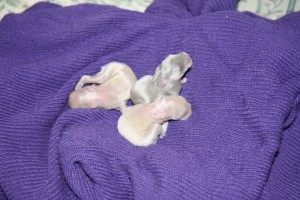
Angora rabbits are hair-and-wool-producing machines. (You know what I mean. Of *course* I know they’re living creatures.) They’ve been made for this job, and can be very impressive at it. So talking about EAs is really going to be talking about what I have them for.
All rabbits have underwool, but angoras have been selectively bred over hundreds (probably thousands) of generations to maximize production of this wool. Just google “English angora image” and you will see some intense examples of wool growth.
I acquired my first EA (whom I optimistically named Serena) at the end of March, 2011; shortly after our house sold.
On the same day I picked up the Ladybug Spinning Wheel I’d been looking at for over a year, I drove out to North Pole and picked out my rabbit.
Having a wheel, I knew I wanted my own fiber animal. I’d considered sheep at first, because that’s what you think of when you think wool, right?
I decided on an angora instead because of the smaller, more manageable size, and because of the processing required by a full home-grown fleece.
For a sheep’s fleece, nothing much like maintenance is required throughout the growing period. There’s physical care for the animal, of course, but nothing specifically for the wool until shearing. At that point one either needs expertise in one’s self or nearby to remove the fleece and begin the real work.
Angora wool needs to be maintained (brushed, combed or “blown” to keep it clear of matts and debris) while growing, but if properly maintained, the wool is ready to spin directly off the rabbit.
There are two ways to harvest the wool: plucking or shearing. As far as I’ve been able to tell (so far) I have one of each type.
Twice now, Serena (my first EA and a doe) has “blown” her coat in a serious way.  It starts small. Then comes loose by the handful.
It starts small. Then comes loose by the handful.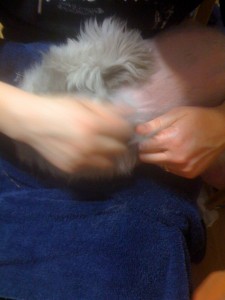
I use one hand to stabilize the skin, and the other to grip pinches of wool and pull the way you pull a brush or comb through your hair: slow and steady so you always can stop before it hurts if you hit a snag.
When it’s done I have a (nearly) naked rabbit. I trimmed around her face so she can see, but left her “apron” (chest and the front of her belly) wool intact, since that’s where she’ll want to pull from for her next litter.
~ ~ ~
Angora wool is crazy-soft, and incredibly warm (7xs the warmth of wool is the comparison I see constantly thrown around, unfortunately with no footnote or substantiation, so I don’t know how “they” came up with that number).
The main problem with angora yarn is that is has little or no “memory.” That is, if you knit a garment with 100% angora, it will stretch (that is the nature of knitting) but it won’t bounce back.
So it seems best-suited for non-fitted items like scarves and shawls.
There are three ways I’m currently experimenting with getting around this.
One is to knit two-as-one, with a strand of my own hand-spun angora and one strand of wool-based yarn.
The other method is to blend the angora fiber with wool (I have some from a friend of mine, which is why I’m so personally familiar with the wool-cleaning process.)
If I needed anything to make me love my wooly rabbits more, I got it in the experience of picking fleece. Yikes.
 Angora and wool don’t like to blend, do you have to do this in several passes.
Angora and wool don’t like to blend, do you have to do this in several passes.
I weighed out equal amounts of wool and angora, hooked it into the teeth and just started carding them together.
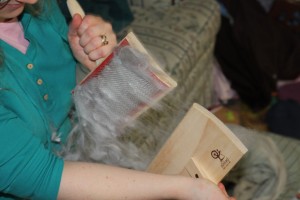 Hey, I never said I knew what I was doing 😉 I just get in and try stuff.
Hey, I never said I knew what I was doing 😉 I just get in and try stuff.
So then once I took it off the combs in the rolag (sort of like a tube of fiber), I tried it out on the Ladybug.
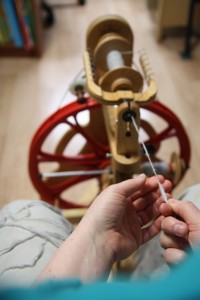 Verdict: it works, but it’s a lot easier to spin 100% angora. Softer and more comfortable.
Verdict: it works, but it’s a lot easier to spin 100% angora. Softer and more comfortable.
I haven’t made it into yarn yet (making yarn typically is three stages of spinning: two spools with a single twist, then wrapping those two twists into a dual-strand yarn), so I haven’t tried out the blend yet.
What I have done is spin one twist of angora with one twist of wool, and used the yarn in the hat I made my boy.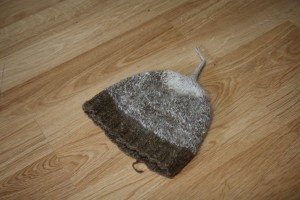
The hat’s really fun, and makes a great explanation piece. The brown cuff is 100% wool– my first hand-spinning, on a huge, 4-inch drop spindle.
The variegated center is yarn spun from a twist each of wool and angora, and the white crown and tail at the top is 100% angora.
So far it’s holding up fine, plenty of memory– it will fit me or the 5-year-old. That’s pretty good.
So this is my third method to compare to decide what works best for incorporating the angora into useable garments.
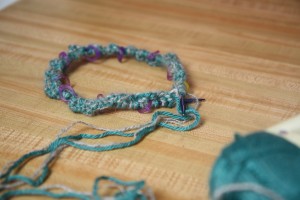
Wow!!!!! I’m impressed!